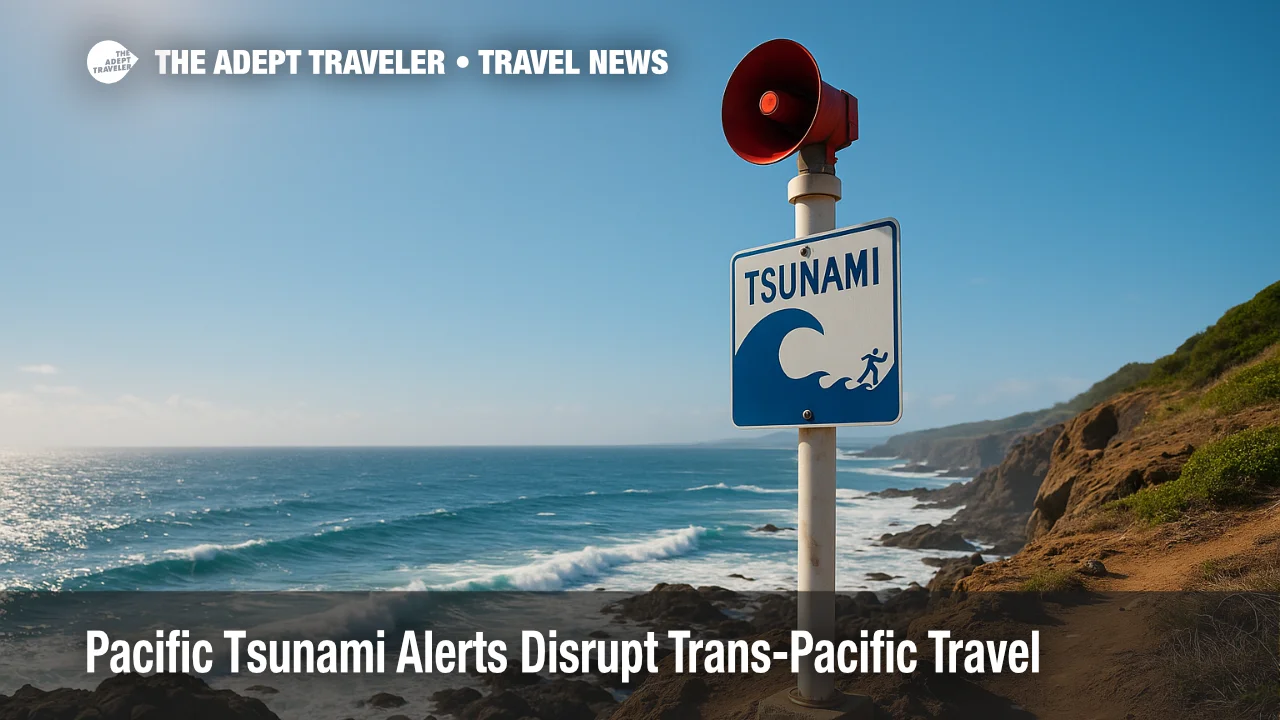Pacific Tsunami Alerts Disrupt Trans-Pacific Travel

A Pacific-wide tsunami advisory followed Tuesday's magnitude 8.8 megathrust quake off Russia's Kamchatka Peninsula, rattling travel plans from Alaska to New Zealand. Overnight warnings kept ports shut, flights on hold, and beach towns on edge well into Wednesday morning. Although the most severe alerts have eased, authorities caution that dangerous surges and strong currents may linger for at least 24 hours. Travelers heading toward affected coastlines should reconfirm every leg of their journey and remain ready for rapid schedule changes. Aftershocks are likely, and additional advisories cannot be ruled out. Cruise lines, airlines, and rail operators have issued flexible rebooking waivers through August 2.
Key Points
- Why it matters: Pacific coasts still face erratic waves and harbor closures
- Cruise calls at Hilo, Kodiak, and Tauranga canceled through August 1
- HNL, SFO, and NRT reported multi-hour overnight flight delays
- Advisory downgraded, but 3-foot surges recorded in California and Oregon
- Aftershocks up to magnitude 7 possible within 48 hours
Snapshot
Tsunami sirens sounded across the North Pacific shortly after the 1124 UTC quake on July 29, 2025. The Pacific Tsunami Warning Center issued warnings for Russia's Kuril Islands and advisories reaching Hawaiʻi, the U.S. West Coast, and South America. Russia's Severo-Kurilsk recorded a five-meter run-up; minor dock damage followed. As of 0730 a.m. EDT, most alerts are now advisories. Kahului and Kona airports resumed departures mid-morning, while Santa Cruz and Crescent City harbors remain closed for inspections. Japan's Tōhoku beaches and several Hokkaido rail lines are still shuttered. South- and Central-American coastlines anticipate sub-meter swells later today.
Background
Megathrust earthquakes along the Kuril-Kamchatka Trench routinely generate basin-wide tsunamis. Tuesday's quake released energy equivalent to roughly 475 million tons of TNT, displacing large volumes of water and sending concentric waves racing across the ocean at jet-liner speed. Historical analogues include the 1952 and 1960 events that caused deadly inundations in Hawaiʻi and Chile. Modern warning networks now relay seismic and sea-level data within minutes, yet travel infrastructure-especially ports and low-lying airports-remains vulnerable. Cruise ships, ferries, and coastal railways must suspend operations until harbor masters verify safe conditions. Airlines, meanwhile, often delay departures or alter routings to avoid potential wave interaction zones.
Latest Developments
Advisories Downgraded, Ports Reopen in Phases
By dawn local time in Hawaiʻi, the Pacific Tsunami Warning Center downgraded watches to advisories. The U.S. Coast Guard allowed outgoing traffic from Honolulu Harbor once currents fell below two knots, but inbound vessels must remain at sea until divers complete dock inspections this afternoon. California's Santa Cruz Harbor reported broken pilings and will stay closed through Thursday. Japan's Meteorological Agency lifted most coastal restrictions except in northern Honshu, where beaches stay off-limits while crews survey seawalls. Chile's Hydrographic and Oceanographic Service expects sub-meter waves around 9 p.m. local time and has advised small-craft operators to remain ashore.
Airlines and Cruisers Issue Waivers, Reroute Traffic
United, Delta, and Hawaiian Airlines granted fee-free rebooking for passengers traveling through August 2 on itineraries touching Hawaiʻi, Alaska, or West Coast hubs. Several HND-SFO and ICN-SEA flights diverted south of the Aleutians, adding up to 90 minutes en route. Carnival, Princess, and Norwegian revised Alaska and Hawaiʻi cruises, skipping Kodiak, Hilo, and Nawiliwili calls this week. P&O Cruises redirected Pacific Explorer from Tauranga to Wellington due to anticipated swell in New Zealand's Bay of Plenty.
Analysis
The swift downgrade of warnings underscores improvements in Pacific tsunami monitoring, yet the event still exposes persistent fragilities in coastal mobility. Harbors remain single-point failures: a three-foot surge can snap mooring lines, scatter debris, and force multiday closures even without inland flooding. For airlines, rerouting around potential wave interaction zones consumes extra fuel and tightens crew-duty windows, cascading into delays across networks. Cruise itineraries, built months ahead, must pivot rapidly, illustrating why travelers should value flexible booking conditions.
Policy differences also emerge. Russia evacuated Severo-Kurilsk residents within 15 minutes, but local airports reopened slowly due to runway inspection protocols. Japan's granular beach advisories help contain risk yet disrupt tourism in regions still recovering from pandemic slowdowns. In the United States, an advisory classification often understates on-shore dangers-a lesson Santa Cruz learned in 2011 and again today. Travelers need clearer messaging on post-surge currents, which remain lethal even after alerts end. The broader takeaway: natural hazards continue to test global travel's resilience, spotlighting the importance of real-time communication and flexible logistics.
Final Thoughts
Coastal travel across the Pacific is regaining momentum, but residual currents, debris, and the threat of aftershocks demand vigilance. Reconfirm flights, cruises, and shore activities, heed local advisories, and allow extra buffer in itineraries. With informed planning and flexibility, travelers can safely navigate the lingering effects of the Pacific tsunami alerts.
